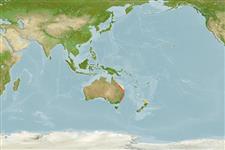Environment: milieu / climate zone / depth range / distribution range
экология
морской; солоноватоводный демерсальный; пределы глубины 0 - 30 m (Ref. 6390). Subtropical; 17°S - 38°S
Western Pacific: endemic to Australia. Present along the east coast between approximately Cairns, Queensland (Ref.27242) and Gippsland lakes in eastern Victoria.
Length at first maturity / Size / Вес / Возраст
Maturity: Lm 50.2 range ? - ? cm
Max length : 120 cm TL самец/пол неопределен; (Ref. 27112); наибольший вес (опубликованные данные): 15.0 kg (Ref. 27248)
Краткое описание
определительные ключи | морфология | морфометрия
колючие лучи спинного плавника (общее число) : 8 - 9; членистые (мягкие) лучи спинного плавника (общее число) : 13 - 14; колючие лучи анального плавника: 0; членистые (мягкие) лучи анального плавника: 13 - 14; позвонки: 27.
Generally inhabit shallow bays and inlets and can be found in estuaries as far as tidal limits (Ref. 27246); they often invade freshwater. They occur over mud, silt gravel, sand and seagrass (mainly Zostera species) beds from intertidal areas to depths of 10 m in Queensland and to 30 m in southern New South Wales. Eggs and larvae are dispersed along the coast by tidal and current movements (Ref. 27112). Small juveniles less than 12 cm TL first appear in coastal bays 1-2 months after spawning. They mainly inhabit shallow mangrove and mud flats and seagrass beds (Ref. 27246, 27245). They are usually solitary but may form loose aggregations (Ref. 2165, 27247). Feed on small fish, crabs, prawns, small crustaceans. octopus, squid and polychaete worms. They have spines on the outer edges of their head which can inflict nasty cuts during handling (pers. comm., Bernard Moss, 2001).
There is conflicting information (Ref. 27246, 27245, 27247) on whether dusky flahead are protandrous sex reversers or not.
Paxton, J.R., D.F. Hoese, G.R. Allen and J.E. Hanley, 1989. Pisces. Petromyzontidae to Carangidae. Zoological Catalogue of Australia, Vol. 7. Australian Government Publishing Service, Canberra, 665 p. (Ref. 7300)
Статус Красного Списка МСОП (Ref. 130435: Version 2024-2)
Угроза для людей
Harmless
Использование человеком
рыболовство: коммерческий; объект спортивного рыболовства: да
дополнительная информация
инструменты
Специальные отчеты
Скачать в формате XML
ресурсы в Интернет
Estimates based on models
Preferred temperature (Ref.
123201): 19.1 - 27.1, mean 25.2 °C (based on 291 cells).
Phylogenetic diversity index (Ref.
82804): PD
50 = 0.5000 [Uniqueness, from 0.5 = low to 2.0 = high].
Bayesian length-weight: a=0.00457 (0.00230 - 0.00908), b=3.09 (2.91 - 3.27), in cm total length, based on LWR estimates for this (Sub)family-body shape (Ref.
93245).
Trophic level (Ref.
69278): 4.1 ±0.52 se; based on food items.
устойчивость к внешним воздействиям (Ref.
120179): средний (среднего размера), минимальное время удвоения популяции 1.4-4.4 года (K=0.22; tm=2).
Fishing Vulnerability (Ref.
59153): High to very high vulnerability (72 of 100).
Nutrients (Ref.
124155): Calcium = 132 [8, 523] mg/100g; Iron = 2.27 [0.58, 6.12] mg/100g; Protein = 19.2 [16.9, 21.6] %; Omega3 = 0.481 [0.216, 1.350] g/100g; Selenium = 54.4 [13.6, 213.1] μg/100g; VitaminA = 4.35 [1.42, 12.68] μg/100g; Zinc = 0.72 [0.34, 1.57] mg/100g (wet weight);
